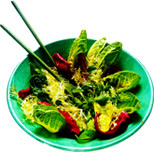 "National Nutrition Month® is a nutrition education and information campaign created annually in March by the Academy of Nutrition and Dietetics. The campaign focuses attention on the importance of making informed food choices and developing sound eating and physical activity habits. This year is the 40th anniversary of National Nutrition Month®." "National Nutrition Month® is a nutrition education and information campaign created annually in March by the Academy of Nutrition and Dietetics. The campaign focuses attention on the importance of making informed food choices and developing sound eating and physical activity habits. This year is the 40th anniversary of National Nutrition Month®."
Here is my personal tip to making an informed food choice. Please take it with a grain of salt.
ALWAYS read the food label.
Recently, I bought a bag of frozen peaches and a bag of frozen raspberries. I didn't bother to look at the label because I was buying fruit. Well, when I tasted the fruit, I could tell instantly it was different. Then I looked at the food label.....
The raspberries- Raspberries and sugar.
The peaches- peaches, malic acid, ascorbic and citric acid (to promote color retention), and natural flavors...
Isn't a peach natural enough?
Foods with more than one ingredient must have an ingredient list on the label. Ingredients are listed in descending order by weight. The top three ingredients are mainly what you are eating.
What to look out for;
- Listing of different kinds of sugars, or wording them differently so they can be separated. Whether the ingredient is high fructose corn syrup, sugar, cane sugar, cane syrup, agave nectar, honey, molasses, etc... these are all sugars. If there are multiples, then sugar needs to be in the top three ingredients. This is what you are eating or feeding your children, no matter how natural or unnatural, high glycemic or low glycemic, it is still sugar.
- Whole wheat does not mean whole grain. Look at the label to make sure it says whole grain. If it doesn't say 100% whole grain, then it is most likely processed whole wheat flour, which means that it has been striped of a lot of it's nutritious benefits and it's really no better then a white flour product.
- If you cannot read it, then make sure you know what it is and why it is used. Most companies add preservatives to lower cost and extend shelf life. Try your best to understand what the strange ingredient is in the product. Look for the same type of product with least of these ingredients in them.
- Beware the fat free, sugar free, calorie free... etc. Many times sugars, sugar substitutes, and unnatural fillers are added as favor replacement. Many of these are also bad for your health. So as above, if you don't like what you see in the top three, if you cannot understand the ingredient list, look for another product that you can understand or eat less of the "un-free" product.
- Make sure you understand the serving size. That bottle of tea, has 2.5 servings in it. That 2.5 goes for the calories and the daily percentages. This is important not only for sugary ice teas, but for salty or oily foods. Calories and percentages count to your wellbeing. Make sure you are filling your body with the right calories and percentages
|
 "National Nutrition Month® is a nutrition education and information campaign created annually in March by the Academy of Nutrition and Dietetics. The campaign focuses attention on the importance of making informed food choices and developing sound eating and physical activity habits. This year is the 40th anniversary of National Nutrition Month®."
"National Nutrition Month® is a nutrition education and information campaign created annually in March by the Academy of Nutrition and Dietetics. The campaign focuses attention on the importance of making informed food choices and developing sound eating and physical activity habits. This year is the 40th anniversary of National Nutrition Month®."
No comments:
Post a Comment